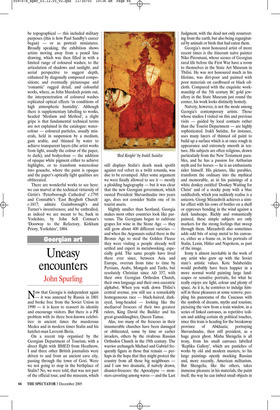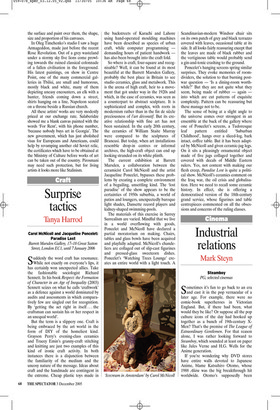Uneasy encounters
John Spurling
Now that Georgia is independent again — it was annexed by Russia in 1801 and broke free from the Soviet Union in 1990 — it is keen to reassert its identity and encourage visitors. But there is a PR problem with its three best-known celebrities: in ancient times the murderous Medea and in modern times Stalin and his hatchet-man Lavrenti Beria.
On a recent trip organised by the Georgian Department of Tourism, with a direct flight with BMED from Heathrow, I and three other British journalists were driven to and from an ancient cave city, passing through the town of Gori. Were we not going to stop in the birthplace of Stalin? No, we were told, that was not part of the official tour, and the museum, which still displays Stalin’s death mask spotlit against red velvet in a twilit rotunda, was due to be revamped. After some argument we were finally allowed to see it — mostly a plodding hagiography — but it was clear that the new Georgian government, which ousted President Shevardnadze two years ago, does not consider Stalin one of its tourist assets.
Slightly smaller than Scotland, Georgia makes most other countries look like parvenus. The Georgians began to cultivate grapes for wine in the Stone Age — they still grow about 400 different varieties and when the Argonauts sailed there in the Bronze Age to steal the Golden Fleece they were visiting a people already well settled and expert in metalworking, especially gold. The same people have lived there ever since, between Asia and Europe, overrun from time to time by Persians, Arabs, Mongols and Turks, but resolutely Christian since AD 337, with their own Georgian Orthodox Church, their own language and their own eccentric alphabet. When you walk down Tbilisi’s central avenue, you still see a remarkably homogeneous race — black-haired, darkeyed, long-headed — looking like the mediaeval frescoes of their two greatest rulers, King David the Builder and his great-granddaughter, Queen Tamar.
Alas, too many of the frescoes in their innumerable churches have been damaged or obliterated, some by time or earlier invaders, others by the rivalrous Russian Orthodox Church in the 19th century. The warrior archangels Michael and Gabriel frequently figure in those that remain — perhaps in the hope that they might protect the country from all those big neighbours and I saw two dramatic, if naïvely drawn, disaster-frescoes: the Apocalypse — monsters cavorting among waves — and the Last Judgment, with the dead not only resurrecting from the earth, but also being regurgitated by animals or birds that had eaten them.
Georgia’s most honoured artist of more recent times is the itinerant naïve painter Niko Pirosmani, whose scenes of Georgian rural life before the First War have a room to themselves in the State Art Museum in Tbilisi. He was not honoured much in his lifetime, was dirt-poor and painted with poor materials on cardboard or black oilcloth. Compared with the exquisite workmanship of the 5th century BC gold jewellery in the State Museum just round the corner, his work looks distinctly homely.
Naïvety, however, is not the mode among Georgia’s contemporary artists. Those whose studios I visited on this and previous visits — guided by local contacts rather than the Tourist Department — are highly sophisticated. Irakli Sutidze, for instance, uses many layers of thinned oil paint to build up a surface which is at once rough in appearance and extremely smooth in texture. His subjects are often religious, drawn particularly from the New Testament parables, and he has a passion for Arthurian myth and for horses — he is an enthusiastic rider himself. His pictures, like parables, transform the ordinary into the mythical and memorable, as in his paintings of a white donkey entitled ‘Donkey Waiting for Christ’ and of a stocky pony with a blue saddlecloth, which you suddenly realise is a unicorn. Giorgi Mirzashvili achieves a similar effect with his rows of bottles on a shelf or cypresses bending in the wind against a dark landscape. Richly and romantically painted, these simple subjects are only markers for the strong feelings that sweep through them. Mirzashvili also sometimes adds odd bits of scrap metal to his canvases, either as a frame or, in his portraits of Stalin, Lenin, Hitler and Napoleon, as part of the image.
Irony is almost inevitable in the work of any artist who grew up with the Soviet state’s artistic values. Kote Sulaberidze would probably have been happier in a more normal world painting large landscapes or sensitive portraits, for what he really enjoys are light, colour and plenty of space. As it is, he contrives to indulge himself in these pleasures at some remove, peopling his panorama of the Caucasus with the symbols of dreams, myths and tourism; picturing the view from a train window, in a series of linked canvases, as repetitive tedium and adding certain sly political touches, since this train is heading for the breakaway province of Abkhazia; portraying Shevardnadze, then still president, as a huge green ghost. Misha Shengelia is all irony, from his small canvases labelled ‘Replika Gallery’, which are pastiches of works by old and modern masters, to his large paintings openly mocking Russian and, more recently, American militarism. But Shengelia, like the others, takes immense pleasure in his materials, the paint itself, the way he can imbed small objects in the surface and paint over them, the shape, size and proportion of his canvases.
In Oleg Timchenko’s studio I saw a huge Armageddon, made just before the recent Rose Revolution. Out of a grey wasteland under a stormy sky five lions come prowling towards the ruined classical colonnade of a fallen civilisation in the foreground. His latest paintings, on show in Centre Point, one of the many commercial galleries in Tbilisi, are small and humorous, mostly black and white, many of them depicting uneasy encounters, an elk with a hunter, friends coming down a street, shirts hanging on a line, Napoleon seated on a throne beside a Russian church.
All these artists’ works are very modestly priced at our exchange rate. Sulaberidze showed me a blank canvas painted with the words ‘For Rent’, with his phone number, ‘because nobody buys art in Georgia’. The new government, which has just abolished visas for Europeans and Americans, could help by revamping another old Soviet relic, the certificates which have to be obtained at the Ministry of Culture before works of art can be taken out of the country. Pirosmani may need such protection, but for living artists it looks more like Stalinism.




























































 Previous page
Previous page